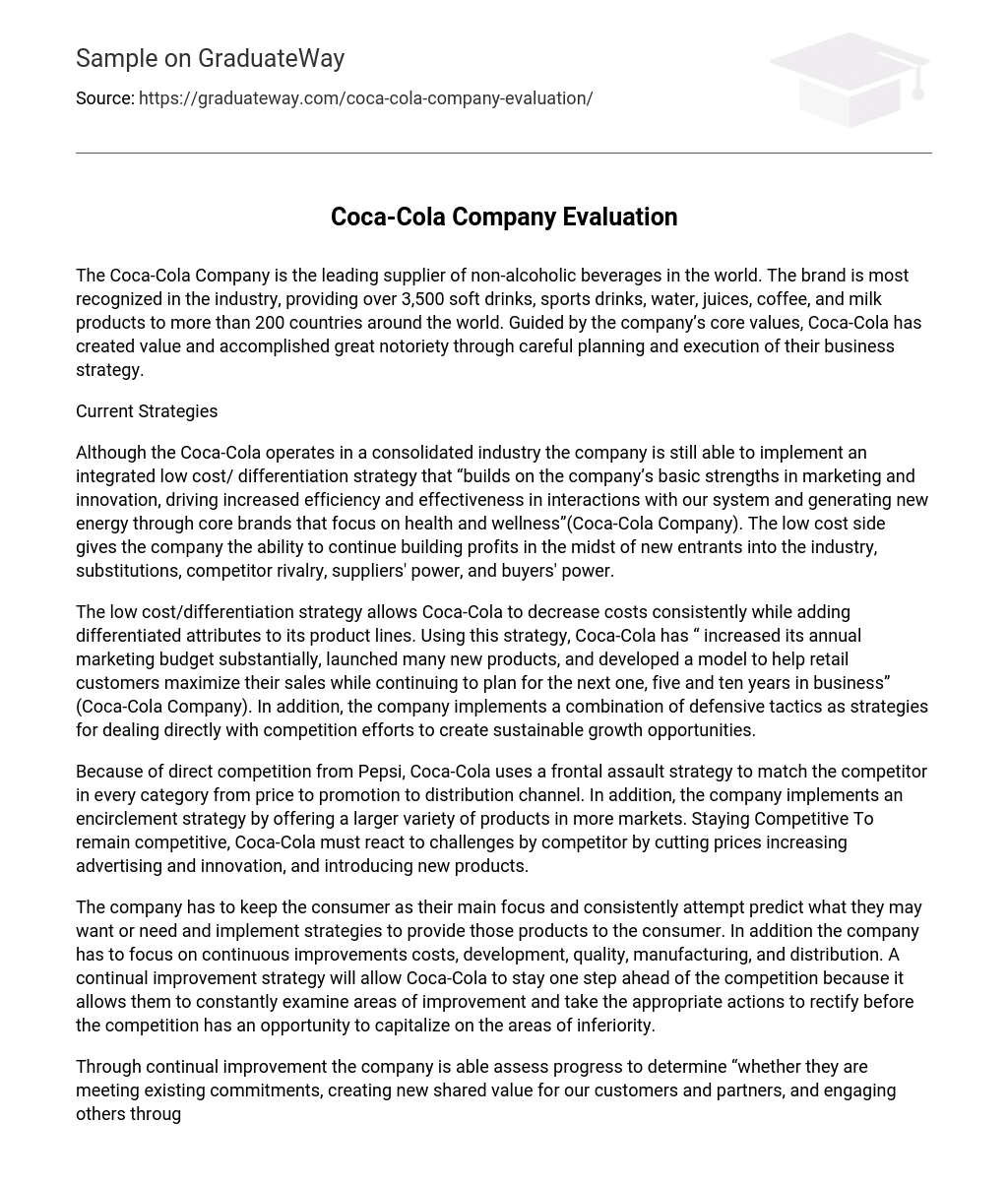The Coca-Cola Company is the leading supplier of non-alcoholic beverages in the world. The brand is most recognized in the industry, providing over 3,500 soft drinks, sports drinks, water, juices, coffee, and milk products to more than 200 countries around the world. Guided by the company’s core values, Coca-Cola has created value and accomplished great notoriety through careful planning and execution of their business strategy.
Current Strategies
Although the Coca-Cola operates in a consolidated industry the company is still able to implement an integrated low cost/ differentiation strategy that “builds on the company’s basic strengths in marketing and innovation, driving increased efficiency and effectiveness in interactions with our system and generating new energy through core brands that focus on health and wellness”(Coca-Cola Company). The low cost side gives the company the ability to continue building profits in the midst of new entrants into the industry, substitutions, competitor rivalry, suppliers’ power, and buyers’ power.
The low cost/differentiation strategy allows Coca-Cola to decrease costs consistently while adding differentiated attributes to its product lines. Using this strategy, Coca-Cola has “ increased its annual marketing budget substantially, launched many new products, and developed a model to help retail customers maximize their sales while continuing to plan for the next one, five and ten years in business” (Coca-Cola Company). In addition, the company implements a combination of defensive tactics as strategies for dealing directly with competition efforts to create sustainable growth opportunities.
Because of direct competition from Pepsi, Coca-Cola uses a frontal assault strategy to match the competitor in every category from price to promotion to distribution channel. In addition, the company implements an encirclement strategy by offering a larger variety of products in more markets. Staying Competitive To remain competitive, Coca-Cola must react to challenges by competitor by cutting prices increasing advertising and innovation, and introducing new products.
The company has to keep the consumer as their main focus and consistently attempt predict what they may want or need and implement strategies to provide those products to the consumer. In addition the company has to focus on continuous improvements costs, development, quality, manufacturing, and distribution. A continual improvement strategy will allow Coca-Cola to stay one step ahead of the competition because it allows them to constantly examine areas of improvement and take the appropriate actions to rectify before the competition has an opportunity to capitalize on the areas of inferiority.
Through continual improvement the company is able assess progress to determine “whether they are meeting existing commitments, creating new shared value for our customers and partners, and engaging others through our leadership team” (Coca-Cola). Furthermore, Coca-Cola has to focus on its positioning strategy. The company has to maintain a positive brand image that coincides with consumers’ life experiences and feelings.
Coca-Cola is an ingredient in the daily life of many consumers, but an increase in health consciousness along with an emphasis on healthy lifestyles has slowed the sales of Coca-Cola’s carbonated soft drinks. Because of the changes in consumer, Coke must implement a focus strategy that considers more health conscious alternatives to attract the segments of the industry not well integrated. “This similarity between the brand and the consumer leads to a high degree of loyalty and makes the purchasing decision easier” (Coca-Cola).
Implementing “selective packaging strategies designed to increase consumer demand for our products and to build a strong returnable base for the Coca-Cola brand” (Coca-Cola), while continuing to develop and expand its beverage portfolio through “innovation, strategic acquisitions and by entering into agreements to jointly acquire companies with The Coca-Cola Company ”(Coca-Cola FEMSA) is another strategic goal. The company may also consider a value chain partnership to help meet short-term commitments while investing to meet long-term goals promoting sustainable growth.
Value chain partnerships result in improved productivity, efficiencies and profitability for the company. Coca-Cola could also choose concentric diversification because if its extensive knowledge of other areas of distribution. Diversifying the product line presents the opportunity for Coca-Cola to surpass the competition for a brief moment until they make attempts to compete. Competitor Influence Every strategic decision on each level is based on the actions of the competitors and has a bearing on competitiveness.
Direct competition causes Coca-Cola to be more aggressive in developing and expanding its products making constant changes, rebranding, advertising heavier, and presenting their products in order to keep sales consistently high. “As a result, we now include sustainability among the key criteria by which we evaluate our business plans and performance. We assess how we are improving our earnings and our competitive position, as well as how we are strengthening the sustainability of our business practices” (Coca-Cola).
In response to Coca-Cola’s strategies, competitors may choose to implement defensive tactics such as raising structural barriers through or increasing the level expected retaliation. Collusion is another tactic that competitors may use to combat Coca-Cola’s strategic decisions. Competitors may also choose to expand and diversify product lines to directly coincide with Coca-Cola. This could make Coca-Cola rethink the initial strategic decisions and re-evaluate the situation to determine if another strategically position is available.
Conclusion
Coca-Cola’s presence in the no-alcoholic beverage industry is one to be reckoned with. The current strategies in place by the company have created an opening for the company to continue to dominating the industry through “elevated sustainability into our business growth agenda and defining our objective as “accelerating sustainable growth to operate in tomorrow’s world” (Coca-Cola). Through the use of proper strategies Coca-Cola gain and maintain competitive advantage while saying one step ahead of the competition. Innovation and diversity prove to be the main sources for Coca-Cola to remain at the forefront of the industry.
References
Coca-Cola Company, 2011 Who We Are. Retrieved April 21, 2012 from www.thecocacola.com/investor relations.
Coca-Cola FEMSA. 2011. Investor Relations retrieved April 23, 2012 from http://www.coca- colafemsa.com/femsa/web/conteudo_en.asp?idioma=1&conta=44&tipo=27617.
Wheelen, Thomas L. and Hunger, J. David, 2010. Concepts in Strategic Management and Business Policy: Achieving Sustainability, 12th Edition





